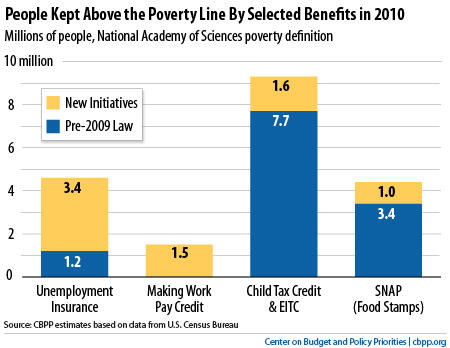BEYOND THE NUMBERS
We are presenting evidence today at the Department of Health and Human Services’ annual Welfare Research and Evaluation Conference that, when it comes to keeping people out of poverty, the 2009 Recovery Act was probably the most effective piece of legislation since the 1935 Social Security Act. As we first described in a paper last November, six temporary stimulus initiatives that President Obama and Congress enacted in 2009 and 2010 kept 6.9 million Americans out of poverty in 2010.
The six provisions — three new or expanded tax credits, two unemployment insurance enhancements, and a SNAP (food stamp) benefit expansion — were originally in the Recovery Act, though President Obama and Congress later extended or expanded some of them.
The government’s official poverty measure counts only cash income. So, to see how these measures affected poverty, we used an alternative poverty measure that also considers the effect of government benefit programs like SNAP and tax credits. Most experts prefer this broader measure, which adopts recommendations of the National Academy of Sciences.

Specifically, we found that:
- Expansions in the Earned Income Tax Credit (EITC) and Child Tax Credit (CTC) kept 1.6 million people out of poverty.
- The Making Work Pay tax credit, which expired at the end of 2010, kept another 1.5 million people out of poverty.
- Expansions in the duration and level of benefits kept 3.4 million people out of poverty.
- Expansions in SNAP benefits kept 1 million people out of poverty.
(These figures total more than 6.9 million in part because some people were kept above the poverty line by more than one program but, in the total, we counted each person only once.)
As the chart shows, existing policies to promote family income also kept millions of additional Americans out of poverty in 2010. For example, the basic SNAP program — not counting the benefit expansions — kept another 3.4 million people out of poverty in 2010.
Moreover, these are just the initial effects of government assistance on recipient households. They don’t show the ripple effect across the economy as government assistance allowed struggling consumers to continue to buy goods and services — one way the Recovery Act helped keep millions of people employed, as my colleague Michael Leachman notes here. Our poverty estimates are conservative because they leave out the anti-poverty effect of these jobs.
To be sure, these figures don’t mean that government assistance staved off all, or even most, recession-related hardship. They don’t factor in, for instance, the families that endured foreclosures on their homes.
Still, these figures show that government assistance kept millions of Americans above the poverty line while the economy was suffering its sharpest deterioration in decades. That is no small accomplishment.
